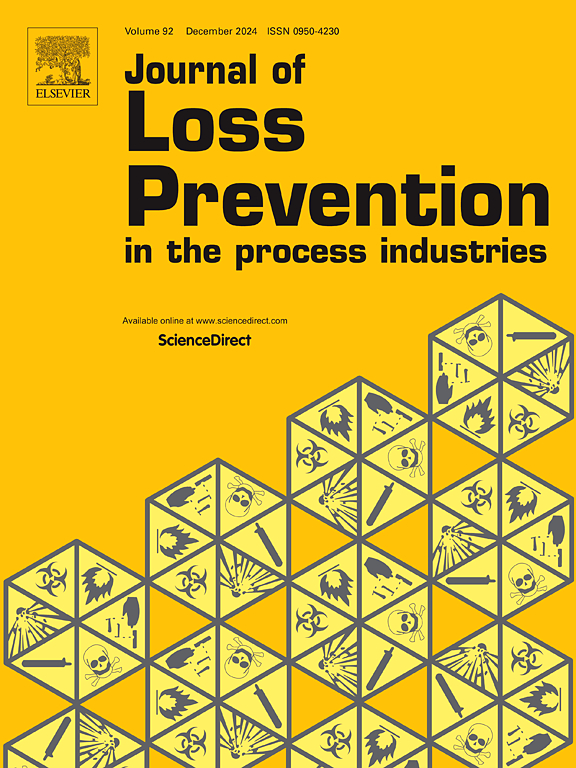圆柱形煤仓自燃过程中温度和氧的时空演化特征分析
IF 3.6
3区 工程技术
Q2 ENGINEERING, CHEMICAL
Journal of Loss Prevention in The Process Industries
Pub Date : 2025-04-25
DOI:10.1016/j.jlp.2025.105659
引用次数: 0
摘要
筒形煤仓因其通风条件较好、贮存时间短,在煤矿现场得到了广泛的应用。主要用于长期或临时存放煤样。然而,基于目前的研究成果,对自燃温度和氧浓度变化的研究相对较少,需要对典型的圆柱形煤仓进行进一步的研究。为此,本研究针对现有圆柱形煤仓储煤相关试验装置的不足,根据煤矿实际储煤的特点,独立搭建了煤仓自燃演化实验系统。选取河南洛阳紫荆煤样为研究对象,测试了煤自燃煤仓横向和纵向温度在自燃煤仓过程中的时空变化,划分了煤自燃煤仓的发展阶段。分析了煤仓自燃不同阶段各测点氧浓度和耗氧量的变化趋势。结果表明,煤仓自燃过程可分为慢加热、快加热、恒温、快冷却和慢冷却四个阶段。此外,当出煤口位置发生漏风时,下部煤体会逐渐自燃。在温度迁移过程中,高温点主要集中在煤仓的中下部,第二层煤体温度趋于655.7℃。下部煤体自燃形成内部空隙,长期处于高温状态。在恒温阶段,观察到煤仓内最低煤样基本保持在400 ~ 600℃之间。靠近下漏风口的煤样燃烧速度快,峰值温度低。由于煤体氧化程度的不同,冷却阶段的持续时间也不同。研究成果对煤仓自燃灾害的防治具有重要的理论指导意义。本文章由计算机程序翻译,如有差异,请以英文原文为准。
Analysis of temporal and spatial evolution characteristics of temperature and oxygen in spontaneous combustion process of cylindrical coal bunker
The cylindrical coal bunker is widely utilized in coal mining sites because of its relatively sound ventilation conditions and short storage of time. It is mainly used to store coal samples for a long time or temporarily. However, based on the current research results, studies into the variation of spontaneous combustion temperature and oxygen concentration is relatively few, and so further research on typical cylindrical coal bunkers is needed. To that end, this study was conducted to look into the shortcomings of the existing test device associated with coal storage in cylindrical coal bunkers, according to the characteristics of actual coal storage in mines, and so an experimental system for spontaneous combustion evolution of coal bunkers was built independently. The Zijing coal sample from Luoyang, Henan Province, was chosen as the research object, the temporal and spatial changes of transverse and longitudinal temperature in the process of spontaneous combustion of coal (SCC) bunker were tested, and the development stage of SCC bunker was divided. Furthermore, an ananlysis of the variation trend of oxygen concentration and oxygen consumption rate at each measuring point in different stages of coal bunker spontaneous combustion was made. The results demonstrated that the spontaneous combustion process of coal bunker were divided into the stages of slow heating, rapid heating, constant temperature, rapid cooling, and slow cooling. Besides, when the air leakage occurred at the position of the coal outlet, the lower coal body could gradually spontaneously combust. In the process of temperature migration, the high temperature points were mainly concentrated in the middle and lower part of the coal bunker, and the temperature of the second layer of coal body tended to reach 655.7 °C. The spontaneous combustion of the lower coal body formed internal voids and was in a high temperature state for a long time. The lowest coal sample in the coal bunker was observed to basically maintain between 400 and 600 °C in the constant temperature stage. The coal sample near the lower air leakage port had a fast combustion rate and a low peak temperature. The duration of the cooling stage was different due to the different oxidation degree of the coal body. The research results have vital theoretical guiding significance for the prevention and control of coal bunker's spontaneous combustion disaster.
求助全文
通过发布文献求助,成功后即可免费获取论文全文。
去求助
来源期刊
CiteScore
7.20
自引率
14.30%
发文量
226
审稿时长
52 days
期刊介绍:
The broad scope of the journal is process safety. Process safety is defined as the prevention and mitigation of process-related injuries and damage arising from process incidents involving fire, explosion and toxic release. Such undesired events occur in the process industries during the use, storage, manufacture, handling, and transportation of highly hazardous chemicals.

 求助内容:
求助内容: 应助结果提醒方式:
应助结果提醒方式:


